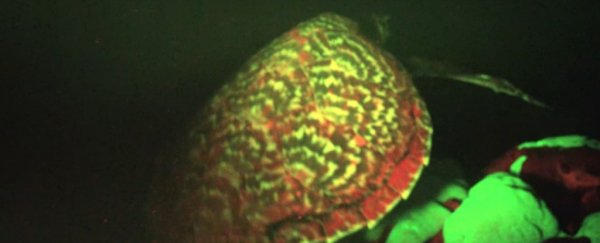A glowing hawksbill sea turtle has been spotted near the Solomon Islands in the Pacific Ocean, and it's believed to the be the first reptile ever known to exhibit biofluorescence - the ability to absorb blue light and then reflect it as a different colour, most often green, red, or orange.
Discovered by biologist and National Geographic explorer David Gruber from City University of New York, the incredibly rare turtle was caught on camera glowing neon red and green under a blue light. You can see the exclusive National Geographic footage below.
"I've been [studying turtles] for a long time and I don't think anyone's ever seen this," Alexander Gaos, director of the Eastern Pacific Hawksbill Initiative, who wasn't involved in the discovery, told Jane Lee over at National Geographic. "This is really quite amazing."
Right now, scientists aren't too sure what's caused this biofluorescence. After playing with the light for a few minutes, the turtle swam away and Gruber didn't pursue it - hawksbill sea turtles are one of the most endangered and protected species in the world, which makes them very difficult to study.
But when he talked to locals about what he'd seen, they showed him several captive hawksbill turtles, and they all glowed red with the same biofluorescence when tested. This suggests that maybe it's a more common strategy than expected.
What we do know is that biofluorescence has only been seen in fish and corals before this, but it's only really been studied in the past decade, so there's still a lot to learn. The ability is different to bioluminescence, which is where animals produce their own light through chemical reactions, or through host bacteria that emit light for them. Last year, it was discovered that sharks, rays, and other fish commonly use the ability for mating.
"[Biofluorescence is] usually used for finding and attracting prey or defence or some kind of communication," said Gaos. But in this instance he thinks it could potentially be used as a type of camouflage strategy for the hawksbill turtle, which is famous for its stealth. After all, the surrounding reefs all glow too.
Gruber told National Geographic that the red on the turtles could indeed be caused by algae, that are potentially growing on their shell as some kind of camouflage strategy. But he believes that the green glow was definitely from the turtle itself, which he describes in the video as a "UFO" that appeared out of nowhere.
The next step is to find out whether turtles in other habitats also have the same ability, and try to work out how they're able to glow, from a chemical point of view. It's possible that the turtles eat a biofluorescent compound to achieve the effect, or they might even be making their own.
Unfortunately, it's unlikely we'll be able to research the ability in the hawksbill. "It'd be fairly difficult to study this turtle because there are so few left and they're so protected," said Gruber. But he suggested that they might be able to study biofluorescence in the slightly more common, and closely related green sea turtle.
